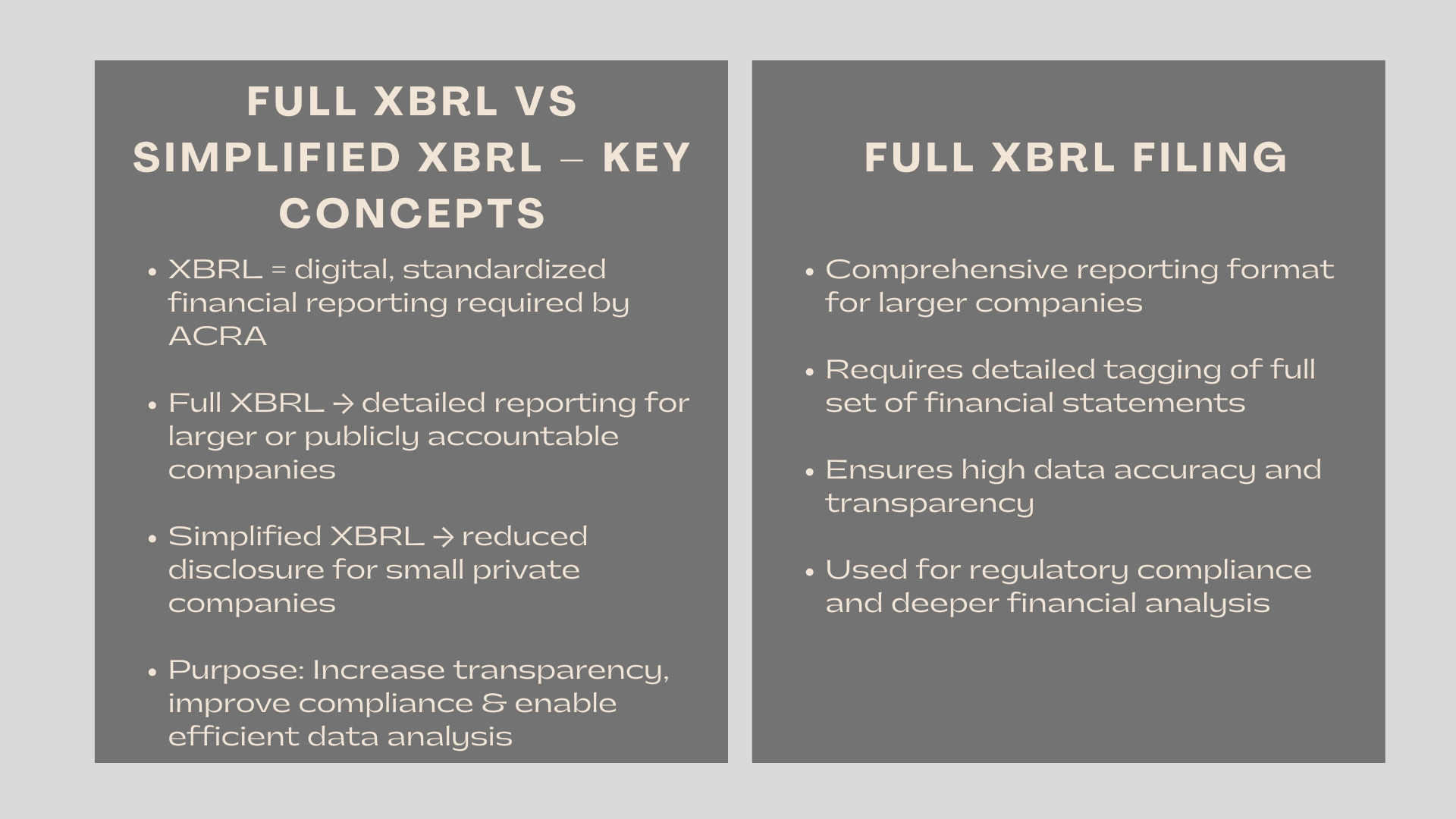Full XBRL vs Simplified XBRL Filing – What’s the Difference?
Introduction to Full XBRL vs Simplified XBRL Filing What is the Difference
Financial reporting is the current digital transformation that is being developed by the Accounting and Corporate Regulatory Authority (ACRA) in Singapore. EXtensible Business Reporting Language (XBRL) usage has emerged as part and parcel of this process where it is possible to submit financial data in a standardized and efficient way. Nevertheless, the question of the difference between Full XBRL and Simplified XBRL filing remains in many companies. Knowing which format to use in your business may simplify compliance and prevent possible accommodation errors.

Knowledge on XBRL Filing in Singapore.
What Is XBRL?
XBRL (eXtensible Business Reporting Language) is an international standard of exchange of financial data. It transforms the conventional financial reports into machine-readable and structured formats that are easier to analyze and compare. In Singapore, ACRA requires the majority of the incorporated companies to submit their financial statements in XBRL using the BizFinx tool.
Why Singapore Adopted XBRL
The decision to switch to XBRL enables ACRA and other interested parties to improve the transparency and the usability of data. Regulators are able to easily follow the financial health of companies by standardizing the reporting of financial information by companies and investors can have easier access to similar financial information. This digitalization initiative augers well with Singaporean goals of maintaining a competitive and innovative business centre.
Full XBRL Filing: Full Reporting of Bigger Entities.
What Is Full XBRL?
The most comprehensive form of financial reporting format that ACRA needs is full XBRL. It is mainly intended to address the bigger or more intricate companies whose financial statement comprises detailed disclosures. A Full XBRL report is full of information in the form of balance sheets, income statement, cash flow statement, equity change and notes to accounts.
Who Should File in Full XBRL Formats.
Non-exempt, and also non-exempt companies with a high level of public responsibility – e.g. listed companies or financial institutions – usually have to file in Full XBRL format. These are the types of businesses that usually have transactions of high volumes, complicated financial instruments or even group forms that require complete disclosure.
Advantages of Full XBRL
Complete XBRL filing is a better data integrity and comparability. It gives investors, analysts and regulators the in-depth company financial assessment through the provision of comprehensive break-down of financial elements in a company. It is also a high-quality level of reporting that can encourage accountability and is consistent with the international best practices in corporate transparency.
XBRL Filing made easy: Reporting made easier in smaller companies.
What Is Simplified XBRL?
Simplified XBRL came to help lighten the compliance load on smaller and less complicated parties. It only needs the important financial data as XBRL format, with the entire gamut of financial statements in PDF format being attached to the submission. This methodology ensures that data is available and at the same time involved minimal effort to tag data.
Which Companies are eligible to use Simplified XBRL.
Small and non-publicly accountable, small organizations that are private firms may choose to use Simplified XBRL filing. In order to qualify, a firm has to fulfill at least two of the following requirements on the last two financial years:
- The total annual revenue of less than S$500,000;
- Total assets not exceeding S$500,000;
- Fewer than 20 shareholders.
These thresholds are necessary to take into consideration the need to minimize the complexity of filing requirements among smaller entities, yet to provide necessary data to the database of ACRA.
Benefits of Simplified XBRL
XBRL is made easy to simplify preparation time and costs. Smaller companies usually have no dedicated accounting staff or experience with XBRL, and thus, a less taxing format of reporting can help to comply. The simplified format also reduces chances of error in the data or inconsistency in tagging, which adds to smooth submissions.
Key Differences between Full and Simplified XBRL Filing.
Detail of Financial Disclosure.
The most obvious distinction between the two is the amount of detail that is needed. Full XBRL requires a heavy disclosure of line items in financial statements whereas Simplified XBRL lays emphasis on data elements. An example is that in Full XBRL, the items in the balance sheet are tagged separately but in Simplified XBRL, similar items are put together.
Targeted User Groups
Full XBRL is designed to serve large or publicly responsible organisations that have a large number of stakeholders- such as regulators, analysts and shareholders. As opposed to this, simplified XBRL serves the needs of small private organizations that do not have many external reporting needs.
Complexity of Preparation
A Full XBRL report takes longer time to prepare and it needs more technical knowledge, which is usually an expert help. Simplified XBRL on the other hand can be modeled faster and therefore it is appropriate when the firm has limited resources available.
Impact on Data Analytics
As a data analytics point of view, Full XBRL will give high-quality granular data that can be used in benchmarking and trend analysis. Simplified XBRL is less detailed, but still provides valuable information that assists ACRA to keep an eye on corporate landscape in Singapore.
Learning the Compliance and Technical Requirements.
BizFinx Preparation Tool of ACRA.
Both Full and Simplified XBRL filing is required to be prepared by BizFinx preparation tool of ACRA. This platform guarantees the normalization of data and validation prior to submission. To keep the company in line with the latest requirements on ACRA, companies need to be sure to use the latest version of taxonomy.
XBRL Filing Common Challenges.
The problem of an inaccurate data tagging, the archaic taxonomy or limited mapping of financial items is rather frequent in firms. These mistakes may result in rejection of filing or imposition of compliance fines. To eliminate these problems, companies ought to frequently upgrade their software and conduct training on the staff who are engaged in financial reporting.
Preparation of XBRL-Outsourcing.
Due to the technical complexity, some companies outsource their XBRL conversion to the professional service provider. Outsourcing is not only accurate, but will save the internal resources especially when the firm is required to prepare various sets of statements or where the accounting staff is limited.
The Significance of the selection of the right format.
The choice of the right format of filing is determined by the size of your company, the structure and the reporting requirements. Turning in an incorrect format could lead to a lack of compliance or resubmission, which would lead to unnecessary delays. A business must thoroughly evaluate their eligibility to the Simplified XBRL and consult with the professional advice in case of doubts, especially when handling complex financial data similar to those learned in the best financial modelling course in Singapore for professionals.
The right filing format will also ensure that there is consistent and efficiency in the reporting periods. An example here is that companies, which expect growth to large scales of Simplified XBRL, might consider preparing early to Full XBRL requirements.
Practical Insights: Comparison and Key Differences
When examining the comparison between full and simplified XBRL filing in Singapore, it becomes evident that the choice hinges on proportionality and compliance efficiency. Full XBRL provides full transparency of larger organizations, and the Simplified XBRL provides a trade-off between regulation and feasibility to the smaller companies. The two can support the ACRA mission of improving the quality of data and the varying capacity of Singaporean businesses.
Similarly, understanding the key differences in XBRL reporting formats for companies helps management teams make informed decisions. These differences go beyond technical data tagging; they go on to affect the audit readiness, the cost of reporting and communication to stakeholders. Companies are able to enhance the efficiency of compliance and accuracy of reporting by matching the selected filing format with the size and complexity of the organization.
Conclusion
The difference between Full XBRL and Simplified XBRL filing in Singapore is critical to the fact of adherence to the requirements of ACRA. The richness and openness of the Full XBRL is useful to larger, publicly accountable organizations, and transparency is flexible to smaller companies with Simplified XBRL. Finally, the correct decision will be based on the structure of the company, resources, and reporting requirements. Knowing these differences, the businesses will be able to make their process of filing smoother, keep track of compliance, and provide valuable input to the digital reporting landscape in Singapore.




